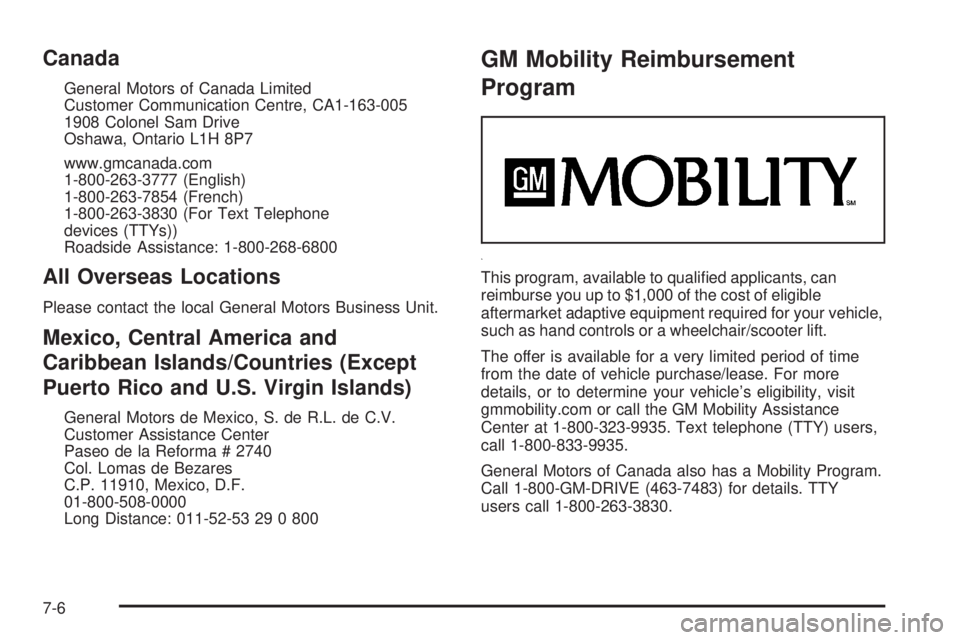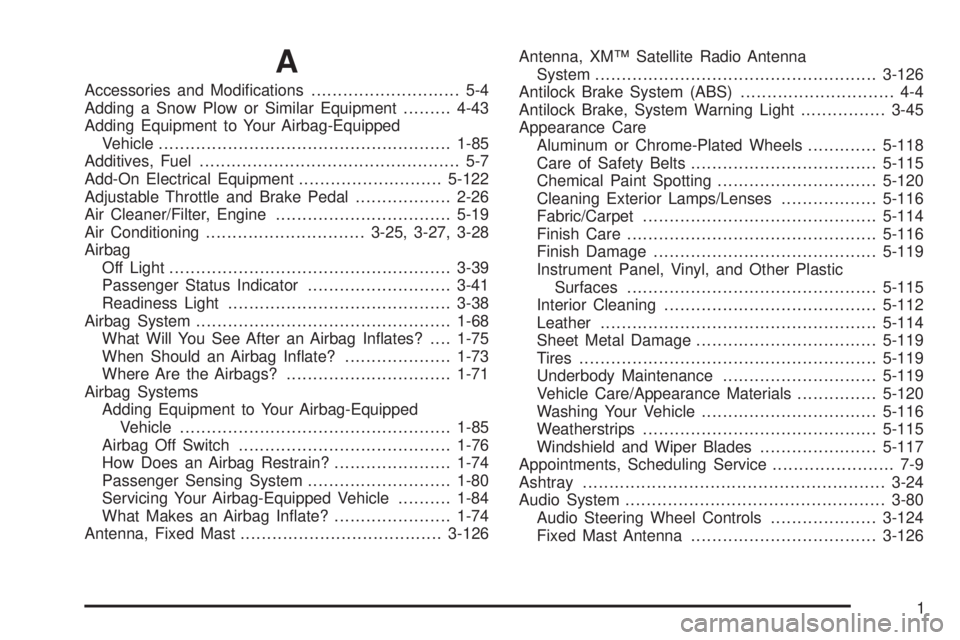2008 GMC SIERRA wheel
[x] Cancel search: wheelPage 533 of 578

Maintenance Footnotes (Gasoline
Engine)
This maintenance section applies to vehicles with a
gasoline engine. If your vehicle has a diesel engine, see
the maintenance schedule section in the DURAMAX
®
Diesel manual.
†The U.S. Environmental Protection Agency or the
California Air Resources Board has determined that the
failure to perform this maintenance item will not nullify
the emission warranty or limit recall liability prior to
the completion of the vehicle’s useful life. We, however,
urge that all recommended maintenance services be
performed at the indicated intervals and the
maintenance be recorded.
#Lubricate the front suspension, steering linkage, and
parking brake cable guides. Control arm ball joints
on 2500/3500 series vehicles require lubrication
but should not be lubricated unless their temperature is
10°F (−12°C) or higher, or they could be damaged.
Control arm ball joints on 1500 series vehicles are
maintenance-free. Vehicles used under severe
commercial operating conditions require lubrication on a
regular basis every 3,000 miles (5 000 km).(a)Visually inspect brake lines and hoses for proper
hook-up, binding, leaks, cracks, chafing, etc. Inspect
disc brake pads for wear and rotors for surface
condition. Inspect drum brake linings/shoes for wear or
cracks. Inspect other brake parts, including drums,
wheel cylinders, calipers, parking brake, etc.
(b)Visually inspect front and rear suspension and
steering system for damaged, loose or missing parts,
signs of wear or lack of lubrication. Inspect power
steering lines and hoses for proper hook-up, binding,
leaks, cracks, chafing, etc. Visually check constant
velocity joints, rubber boots, and axle seals for leaks.
(c)Visually inspect hoses and have them replaced
if they are cracked, swollen, or deteriorated. Inspect all
pipes, fittings and clamps; replace with genuine parts
as needed. To help ensure proper operation, a pressure
test of the cooling system and pressure cap and
cleaning the outside of the radiator and air conditioning
condenser is recommended at least once a year.
(d)Inspect wiper blades for wear, cracking, or
contamination. Clean the windshield and wiper blades, if
contaminated. Replace wiper blades that are worn or
damaged. See Windshield Wiper Blade Replacement on
page 5-65andWindshield and Wiper Blades on
page 5-117for more information.
6-9
Page 535 of 578

(l)Extreme Duty Service: Change transfer case fluid if
the vehicle is mainly driven off-road in four-wheel
drive, or is used for heavy trailer towing. Farming,
mining, forestry, and Department of Natural Resources
(DNR) vehicles meet this definition.
(m)During any maintenance, if a power washer is used
to clean mud and dirt from the underbody, care should be
taken to not directly spray the transfer case output seals.
High pressure water can overcome the seals and
contaminate the transfer case fluid. Contaminated fluid
will decrease the life of the transfer case and should be
replaced.
(n)Vehicles with diesel engine or with GVWR above
10,000 lbs (4 536 kg) only: Inspect shields for damage or
looseness. Adjust or replace as required. This is a
Noise Emission Control Service. Applicable to vehicles
sold in the United States and recommended for
vehicles sold in Canada.
(p)If you drive regularly under dusty conditions, inspect
the filter or change indicator (if equipped) at each
engine oil change.
(q)Visually inspect belt for fraying, excessive cracks, or
obvious damage. Replace belt if necessary.Owner Checks and Services
These owner checks and services should be performed
at the intervals speci�ed to help ensure the safety,
dependability, and emission control performance of your
vehicle. Your dealer/retailer can assist you with these
checks and services.
Be sure any necessary repairs are completed at once.
Whenever any �uids or lubricants are added to your
vehicle, make sure they are the proper ones, as shown
inRecommended Fluids and Lubricants on page 6-15.
At the First 100, 1,000 and 6,000
Miles (160, 1 600 and 10 000 km)
For vehicles with dual wheels, check dual wheel
nut torque. For proper torque, seeCapacities and
Specifications on page 5-130.
At Each Fuel Fill
It is important to perform these underhood checks at
each fuel fill.
6-11
Page 539 of 578

Recommended Fluids and
Lubricants
This maintenance section applies to vehicles with a
gasoline engine. If your vehicle has a diesel engine, see
the maintenance schedule section in the DURAMAX
®
Diesel manual.
Fluids and lubricants identi�ed below by name, part
number, or speci�cation can be obtained from your
dealer/retailer.
Usage Fluid/Lubricant
Engine OilEngine oil which meets GM
Standard GM6094M and displays
the American Petroleum Institute
Certi�ed for Gasoline Engines
starburst symbol. To determine the
proper viscosity for your vehicle’s
engine, seeEngine Oil (Gasoline
Engine) on page 5-15.
Engine Coolant50/50 mixture of clean, drinkable
water and use only DEX-COOL
®
coolant. SeeEngine Coolant on
page 5-28.
Hydraulic Brake
SystemDelco
®Supreme 11 Brake Fluid or
equivalent DOT-3 brake �uid.
Windshield
WasherOptikleen
®Washer Solvent.
Usage Fluid/Lubricant
Power Steering
SystemGM Power Steering Fluid
(GM Part No. U.S. 89021184,
in Canada 89021186).
Automatic
TransmissionDEXRON
®-VI Automatic
Transmission Fluid.
Key Lock
CylindersMulti-Purpose Lubricant, Superlube
(GM Part No. U.S. 12346241,
in Canada 10953474).
Floor Shift
LinkageLubriplate Lubricant Aerosol
(GM Part No. U.S. 12346293, in
Canada 992723) or lubricant
meeting requirements of NLGI #2
Category LB or GC-LB.
Chassis
LubricationChassis Lubricant (GM Part No.
U.S. 12377985, in Canada
88901242) or lubricant meeting
requirements of NLGI #2, Category
LB or GC-LB.
Front Axle
(1500 Series) -
Four-Wheel
DriveSAE 80W-90 Axle Lubricant
(GM Part No. U.S. 89021671,
in Canada 89021672).
Front Axle
(1500 HD, 1500
AWD, 2500,
2500 HD, and
3500 Series)SAE 75W-90 Synthetic Axle
Lubricant (GM Part No. U.S.
89021677, in Canada 89021678)
meeting GM Speci�cation 9986115.
6-15
Page 540 of 578

Usage Fluid/Lubricant
Rear AxleSAE 75W-90 Synthetic Axle
Lubricant (GM Part No. U.S.
89021677, in Canada 89021678)
meeting GM Speci�cation 9986115.
Transfer Case
(Four-Wheel
Drive)DEXRON
®-VI Automatic
Transmission Fluid.
Front Axle
Propshaft
Spline or
One-Piece
Propshaft
Spline
(Two-Wheel
Drive with
4-Speed Auto.
Trans.)Spline Lubricant, Special Lubricant
(GM Part No. U.S. 12345879, in
Canada 10953511) or lubricant
meeting requirements of GM
9985830.
Rear Driveline
Center SplineChassis Lubricant (GM Part No.
U.S. 12377985, in Canada
88901242) or lubricant meeting
requirements of NLGI #2, Category
LB or GC-LB.
Hood HingesMulti-Purpose Lubricant, Superlube
(GM Part No. U.S. 12346241, in
Canada 10953474).
Usage Fluid/Lubricant
Body Door
Hinge Pins,
Tailgate Hinge
and Linkage,
Folding Seats,
and Fuel Door
HingeMulti-Purpose Lubricant, Superlube
(GM Part No. U.S. 12346241, in
Canada 10953474).
Tailgate Handle
Pivot Points,
Hinges, Latch
Bolt, and
LinkageMulti-Purpose Lubricant, Superlube
(GM Part No. U.S. 12346241, in
Canada 10953474).
Weatherstrip
ConditioningWeatherstrip Lubricant (GM Part No.
U.S. 3634770, in Canada 10953518)
or Dielectric Silicone Grease (GM
Part No. U.S. 12345579, in Canada
992887).
Weatherstrip
SqueaksSynthetic Grease with Te�on,
Superlube (GM Part No. U.S.
12371287, in Canada 10953437).
6-16
Page 552 of 578

Canada
General Motors of Canada Limited
Customer Communication Centre, CA1-163-005
1908 Colonel Sam Drive
Oshawa, Ontario L1H 8P7
www.gmcanada.com
1-800-263-3777 (English)
1-800-263-7854 (French)
1-800-263-3830 (For Text Telephone
devices (TTYs))
Roadside Assistance: 1-800-268-6800
All Overseas Locations
Please contact the local General Motors Business Unit.
Mexico, Central America and
Caribbean Islands/Countries (Except
Puerto Rico and U.S. Virgin Islands)
General Motors de Mexico, S. de R.L. de C.V.
Customer Assistance Center
Paseo de la Reforma # 2740
Col. Lomas de Bezares
C.P. 11910, Mexico, D.F.
01-800-508-0000
Long Distance: 011-52-53 29 0 800
GM Mobility Reimbursement
Program
This program, available to quali�ed applicants, can
reimburse you up to $1,000 of the cost of eligible
aftermarket adaptive equipment required for your vehicle,
such as hand controls or a wheelchair/scooter lift.
The offer is available for a very limited period of time
from the date of vehicle purchase/lease. For more
details, or to determine your vehicle’s eligibility, visit
gmmobility.com or call the GM Mobility Assistance
Center at 1-800-323-9935. Text telephone (TTY) users,
call 1-800-833-9935.
General Motors of Canada also has a Mobility Program.
Call 1-800-GM-DRIVE (463-7483) for details. TTY
users call 1-800-263-3830.
7-6
Page 565 of 578

A
Accessories and Modi�cations............................ 5-4
Adding a Snow Plow or Similar Equipment.........4-43
Adding Equipment to Your Airbag-Equipped
Vehicle.......................................................1-85
Additives, Fuel................................................. 5-7
Add-On Electrical Equipment...........................5-122
Adjustable Throttle and Brake Pedal..................2-26
Air Cleaner/Filter, Engine.................................5-19
Air Conditioning..............................3-25, 3-27, 3-28
Airbag
Off Light.....................................................3-39
Passenger Status Indicator...........................3-41
Readiness Light..........................................3-38
Airbag System................................................1-68
What Will You See After an Airbag In�ates?....1-75
When Should an Airbag In�ate?....................1-73
Where Are the Airbags?...............................1-71
Airbag Systems
Adding Equipment to Your Airbag-Equipped
Vehicle...................................................1-85
Airbag Off Switch........................................1-76
How Does an Airbag Restrain?......................1-74
Passenger Sensing System...........................1-80
Servicing Your Airbag-Equipped Vehicle..........1-84
What Makes an Airbag In�ate?......................1-74
Antenna, Fixed Mast......................................3-126Antenna, XM™ Satellite Radio Antenna
System.....................................................3-126
Antilock Brake System (ABS)............................. 4-4
Antilock Brake, System Warning Light................3-45
Appearance Care
Aluminum or Chrome-Plated Wheels.............5-118
Care of Safety Belts...................................5-115
Chemical Paint Spotting..............................5-120
Cleaning Exterior Lamps/Lenses..................5-116
Fabric/Carpet............................................5-114
Finish Care...............................................5-116
Finish Damage..........................................5-119
Instrument Panel, Vinyl, and Other Plastic
Surfaces
...............................................5-115
Interior Cleaning........................................5-112
Leather....................................................5-114
Sheet Metal Damage..................................5-119
Tires........................................................5-119
Underbody Maintenance.............................5-119
Vehicle Care/Appearance Materials...............5-120
Washing Your Vehicle.................................5-116
Weatherstrips............................................5-115
Windshield and Wiper Blades......................5-117
Appointments, Scheduling Service....................... 7-9
Ashtray.........................................................3-24
Audio System.................................................3-80
Audio Steering Wheel Controls....................3-124
Fixed Mast Antenna...................................3-126
1
Page 567 of 578

Center High-Mounted Stoplamp (CHMSL) and
Cargo Lamp...............................................5-61
Center Seat...................................................1-12
Chains, Tire...................................................5-90
Charging System Light....................................3-43
Check
Engine Light...............................................3-48
Checking Things Under the Hood......................5-12
Chemical Paint Spotting.................................5-120
Child Restraints
Child Restraint Systems...............................1-42
Infants and Young Children...........................1-38
Lower Anchors and Tethers for Children..........1-45
Older Children.............................................1-35
Securing a Child Restraint in a Rear
Seat Position...........................................1-55
Securing a Child Restraint in the Center
Front Seat Position...................................1-57
Securing a Child Restraint in the Right Front
Seat Position...........................1-58, 1-62, 1-66
Where to Put the Restraint...........................1-44
Cigarette Lighter.............................................3-24
Cleaning
Aluminum or Chrome-Plated Wheels.............5-118
Exterior Lamps/Lenses................................5-116
Fabric/Carpet............................................5-114
Finish Care...............................................5-116
Instrument Panel, Vinyl, and Other Plastic
Surfaces...............................................5-115Cleaning (cont.)
Interior.....................................................5-112
Leather....................................................5-114
Tires........................................................5-119
Underbody Maintenance.............................5-119
Washing Your Vehicle.................................5-116
Weatherstrips............................................5-115
Windshield and Wiper Blades......................5-117
Climate Control System...........................3-25, 3-27
Dual Automatic............................................3-28
Outlet Adjustment........................................
3-33
Clock, Setting.................................................3-81
Collision Damage Repair..................................7-11
Compass...............................................2-55, 2-57
Content Theft-Deterrent....................................2-18
Control of a Vehicle.......................................... 4-3
Coolant
Engine Temperature Gage............................3-46
Heater, Engine............................................2-26
Surge Tank Pressure Cap.............................5-30
Cooling System..............................................5-34
Cruise Control................................................3-14
Cruise Control Light........................................3-52
Cupholder(s)..................................................2-75
Customer Assistance Information
Courtesy Transportation.................................. 7-9
Customer Assistance for Text
Telephone (TTY) Users............................... 7-5
Customer Assistance Offices........................... 7-5
3
Page 569 of 578

Electrical System (cont.)
Instrument Panel Fuse Block.......................5-124
Power Windows and Other Power Options....5-123
Underhood Fuse Block...............................5-126
Windshield Wiper Fuses.............................5-123
Engine
Air Cleaner/Filter.........................................5-19
Check and Service Engine Soon Light............3-48
Coolant......................................................5-28
Coolant Heater............................................2-26
Coolant Temperature Gage...........................3-46
Drive Belt Routing.......................................6-18
Engine Compartment Overview......................5-14
Exhaust.....................................................2-53
Fan Noise..................................................5-39
Fast Idle System.........................................2-25
Oil .............................................................5-15
Oil Life System...........................................5-18
Overheated Protection Operating Mode...........5-33
Overheating................................................5-30
Running While Parked..................................2-54
Starting......................................................2-24
Entry Lighting.................................................3-21
Event Data Recorders.....................................7-17
Exit Lighting...................................................3-21
Extender, Safety Belt.......................................1-35
Exterior Lamps...............................................3-17F
Fast Idle System............................................2-25
Filter
Engine Air Cleaner......................................5-19
Finish Damage.............................................5-119
Fixed Mast Antenna.......................................3-126
Flashers, Hazard Warning.................................. 3-8
Flash-to-Pass.................................................3-11
Flat Tire........................................................5-91
Flat Tire, Changing.........................................5-92
Flat Tire, Storing...........................................5-108
Fluid.....................................................5-22, 5-25
Power Steering...........................................5-39
Windshield Washer......................................5-40
Fog Lamp
Fog ...........................................................3-20
Fog Lamp Light..............................................3-52
Four-Wheel Drive....................................2-36, 5-52
Four-Wheel-Drive Light....................................3-53
Front Axle......................................................5-54
Fuel............................................................... 5-6
Additives...................................................... 5-7
California Fuel.............................................. 5-7
E85 (85% Ethanol)........................................ 5-8
Filling a Portable Fuel Container....................5-12
Filling the Tank...........................................5-10
5